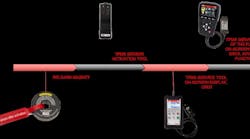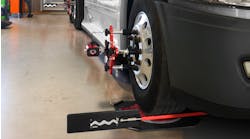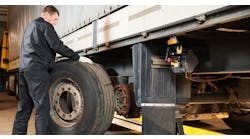When the Tire Pressure Monitoring System (TPMS) warning light comes on the dash, there are many possible reasons, all of which are critical to correct in order to maintain a safe system.
"Safety is the most important benefit of TPMS, which means shops must continue to focus on the role that proper tire inflation plays in the operation of the vehicle," ATEQ's Sheila Stevens, marketing coordinator, says.
So, when a customer comes into the shop for service, an important first step may be educating the customer on the importance of tire pressure to reduce accidents, and furthermore lead to fuel savings and improved gas mileage.
"Businesses that are successful selling TPMS [services] are typically the ones that can explain what it is and demonstrate their expertise," Bartec USA CEO Scot Holloway says. "Tire shops that show, through proper inspection procedures, what’s really going on with their customer’s wheel and tires and TPMS sensors are able to sell the sensor service."
Stevens agrees that communicating a need for proper maintenance and sharing knowledge with customers is the driving factor behind selling TPMS service in a shop.
"When a TPMS sensor, valve or service kit is necessary to install, customers who learn from an informed service pro more willingly opt in for TPMS service," Stevens says. "The customer profits from great service, which can translate into repeat business. Therefore, shops can boost their bottom line with professional TPMS service."
Although expertise and experience is important in any repair, tire shops that specialize in TPMS aren't the only repair shops that can benefit from this revenue opportunity, says Autel's Marketing Director Daniel Bemiss. There are several levels of TPMS service that can be performed by service and body shops.
"TPMS tools that offer easier to pinpoint system faults translate into easier to perform TPMS service,” Bemiss explains.“Suddenly more shops can complete normal TPMS repairs in house and only require tire shop help for the more complicated tire repairs or replacement programming.”
Repair recommendations
In order to integrate TPMS into regular service, start by inspecting and testing the system's function every time the vehicle is in for service, recommends Bartec's Holloway.
"Like regular tread inspection, testing the TPMS is a great place to start when discussing TPMS service with the customer," Holloway says. "'Test Before You Touch' is a great place to start in order to maximize revenue, it also is a great way to reduce liability. Sensors that have stopped functioning can often times take many miles and/or days before they show themselves as a “flashing light” on the instrument panel.
"By testing the customer’s sensors before any work begins, you can easily discover non-functioning sensors. Instead of potentially 'eating the cost' of a failed sensor after the job’s complete, you now have the opportunity to sell them a replacement sensor," Holloway says.
While TPMS sensors have a battery that will generally last a long time untouched, unless damaged or plugged up with sealant, there are other TPMS components that may require more regular attention, Holloway says.
"The valve stem (which the sensor is attached to) needs regular maintenance or replacement," Holloway says. "Aluminum valve stems are attached to the wheel via a threaded nut and various sealing pieces. The threads on the nut have a special coating to prevent galvanic corrosion. These pieces, the nut, the valve core all corrode and decay over time. It is always advised that every time the tire is taken off the wheel, these “service items” be replaced."
Maximizing profit
Time spent on repairs goes hand-in-hand with revenue.
"An advanced TPMS tool can save owners time and money in the shop and keep customers safe on the road," ATEQ's Stevens says. "TPMS tools have come a long way since the beginning of TPMS, from a magnet, to a sensor activation tool, to an advanced TPMS tool with on-screen display, OBDII and advanced functions. The return on investment of advanced TPMS tools can save shop owners thousands per year."
Stevens outlines the time spent on TPMS services with advanced TPMS tools:
· Scan VIN to identify vehicle make, model, year (2 seconds)
· Read four TPMS sensors (26 seconds)
· Find DLC location / OBDII registration from on-screen display locator (15 seconds)
· Enter VIN and print out test report (3 seconds)
· OBD relearn procedure with step-by-step instructions (2 minutes or less)
Autel's Bemiss says easier to use TPMS tools, like ones with a single screen overview of the whole system, offer quicker identification of TPMS faults, therefore also leading to quicker repair time.
"Cutting down repair management time is the key to maximizing technician billable hours," Bemiss says.




